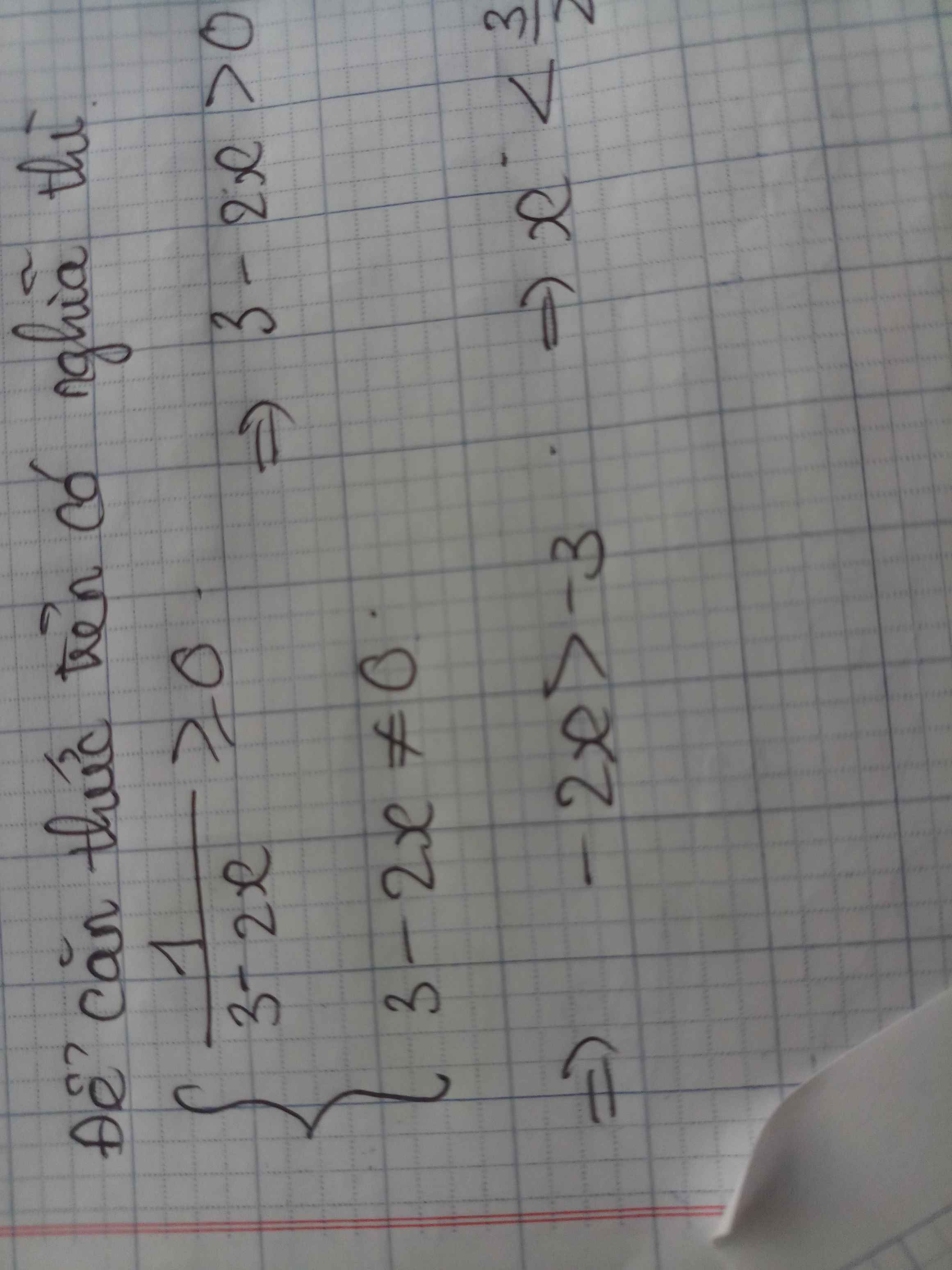Hãy nhập câu hỏi của bạn vào đây, nếu là tài khoản VIP, bạn sẽ được ưu tiên trả lời.

Để \(\sqrt{\dfrac{1}{3-2x}}\) có nghĩa
Khi\(\dfrac{1}{3-2x}\ge0\)
\(\Leftrightarrow3-2x>0\)
\(\Leftrightarrow-2x< -3\)
\(\Leftrightarrow x>\dfrac{3}{2}\)

Để \(\sqrt{\dfrac{2+x}{5-x}}\) có nghĩa
<=> \(\dfrac{2+x}{5-x}\ge0\)
<=> (2+x)(5-x) \(\ge0\) và 5-x\(\ne\)0
<=> \(\left[{}\begin{matrix}x\le-2\\x\ge5\end{matrix}\right.\) và x\(\ne\)5
<=> \(\left[{}\begin{matrix}x\le-2\\x>5\end{matrix}\right.\)
cái này bạn để ý có 2 mốc là -2 và 5, trái dấu thì trong khoảng, cùng dấu thì ngoài khoảng

` ĐK:(-5)/(x^{2}+6)>=0`
Vì `-5<0` và `x^{2}+6>0`
`->(-5)/(x^{2}+6)<0`
Vậy căn thức trên không tồn tại, không có giá trị của `x` thỏa mãn

Để căn thức có nghĩa thì:
\(\sqrt{\dfrac{1}{-1+x}}>0\) và \(-1+x\ne0\)
\(\Leftrightarrow x>1\)
\(ĐKXĐ\left\{{}\begin{matrix}\dfrac{1}{-1+x}\ge0\\-1+x\ne0\end{matrix}\right.\) ( Tử và mẫu cùng dấu )
Mà 1 > 0 \(\Rightarrow-1+x>0\)
\(\Leftrightarrow\) \(x>1\)

`ĐK:(x-1)/(x+2)>=0`
`TH1:`
`x-1>=0` và `x+2>0`
`<=>x>=1` và `x> -2`
`<=>x>=1`
`TH2:
`x-1\le0` và `x+2<0`
`<=>x\le1` và `x< -2`
`<=>x< -2`
Vậy `x>=1` hoặc `x< -2` thì căn thức có nghĩa
ĐKXĐ: \(\left[{}\begin{matrix}x\ge1\\x< -2\end{matrix}\right.\)

x+√(x^2+3)=3/(y+√(y^3))=3(y-√(y^2+3)/-a(trục căn thức)
x+√(x^2+3)=-y+√(y^2+3) suy ra x+y=√(y^2+3)-√(x^2+3)(1)
Tương tự,x+y=√(x^2+3)-√(y^2+3)(2)
Cộng (1),(2) theo vế suy ra 2(x+y)=0 suy ra x+y=0
hay E=0.
Vậy E=0
nhân \(-x+\sqrt{x^2+3}\) vào 2 vế ta đc : \(\left(-x^2+x^2+3\right)\left(y+\sqrt{y^2+3}\right)=\)\(3\left(-x+\sqrt{x^2+3}\right)\)
<=> \(y+\sqrt{y^2+3}=-x+\sqrt{x^2+3}\)<=> \(y+\sqrt{y^2+3}+x-\sqrt{x^2+3}=0\)__(1)___
làm tương tự ta đc \(\left(-y+\sqrt{y^2+3}\right)\left(x+\sqrt{x^2+3}\right)\)\(=3\left(-y+\sqrt{y^2+3}\right)\)
<=> \(x+\sqrt{x^2+3}=-y+\sqrt{y^2+3}\)<=> \(x+\sqrt{x^2+3}+y-\sqrt{y^2+3}=0\)__(2)__
lấy (1) + (2) => 2(x+y) =0 => x+y=0
lấy

Bài 1:
1. \(\sqrt{a}\)có nghĩa <=> \(a\ge0\)
2. a) \(\sqrt{2x+6}\)có nghĩa <=> \(2x+6\ge0\)
\(\Leftrightarrow2x\ge-6\)
\(x\ge-3\)
b)\(\sqrt{\frac{-2}{2x-3}}\) có nghĩa \(\Leftrightarrow\frac{-2}{2x-3}\ge0\)
có -2 < 0
\(\Leftrightarrow\hept{\begin{cases}2x-3\ne0\\2x-3\le0\end{cases}}\)
\(\Leftrightarrow\hept{\begin{cases}2x\ne3\\2x\le3\end{cases}}\)
\(\Leftrightarrow\hept{\begin{cases}x\ne\frac{3}{2}\\x\le\frac{3}{2}\end{cases}}\)
\(\Rightarrow x< \frac{3}{2}\)
Bài 4 :
\(P=\left(\frac{\sqrt{x}}{\left(\sqrt{x}-1\right).\sqrt{x}}-\frac{\sqrt{x}-1}{\sqrt{x}.\left(\sqrt{x}-1\right)}\right):\left(\frac{\left(\sqrt{x}+1\right)\left(\sqrt{x}-1\right)}{\left(\sqrt{x}-2\right)\left(\sqrt{x}-1\right)}-\frac{\left(\sqrt{x}+2\right)\left(\sqrt{x}-2\right)}{\left(\sqrt{x}-1\right)\left(\sqrt{x}-2\right)}\right)\)
\(\Leftrightarrow\left(\frac{\sqrt{x}-\sqrt{x}+1}{\sqrt{x}.\left(\sqrt{x}-1\right)}\right):\left(\frac{\left(x-1\right)-\left(x-4\right)}{\left(\sqrt{x}-2\right).\left(\sqrt{x}-1\right)}\right)\)
\(\Leftrightarrow\left(\frac{1}{\sqrt{x}.\left(\sqrt{x}-1\right)}\right):\left(\frac{3}{\left(\sqrt{x}-2\right)\left(\sqrt{x}-1\right)}\right)\)
\(\Leftrightarrow\left(\frac{1}{\sqrt{x}.\left(\sqrt{x}-1\right)}\right).\left(\frac{\left(\sqrt{x}-2\right).\left(\sqrt{x}-1\right)}{3}\right)\)
\(\Leftrightarrow\frac{\sqrt{x}-2}{3\sqrt{x}}\) \(\left(ĐKXĐ:x>0;x\ne4;x\ne1\right)\)
b) \(P=\frac{1}{4}\)
\(\Leftrightarrow\frac{\sqrt{x}-2}{3\sqrt{x}}=\frac{1}{4}\)
\(\Leftrightarrow4\sqrt{x}-8=3\sqrt{x}\)
\(\Leftrightarrow4\sqrt{x}-3\sqrt{x}=8\)
\(\Leftrightarrow\sqrt{x}=8\)
\(\Leftrightarrow x=64\left(TMĐXĐ\right)\)
Vậy khi \(P=\frac{1}{4}\) thì x=64

Vì `2>0` và `x^{2}>0` ( Với `x\ne0` )
`->(2)/(x^{2})>0`
Vậy với mọi giá trị của `x` thì căn thức đều có nghĩa ( `x\ne0` )
ĐKXĐ: \(x\ne0\)